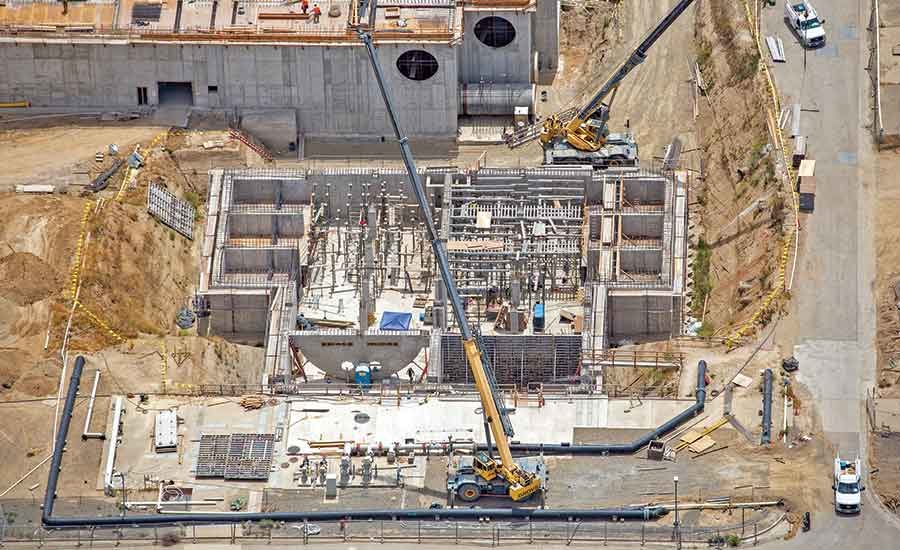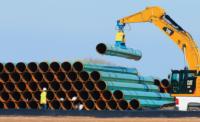With daunting compliance deadlines on the horizon, Sacramento Regional County Sanitation District, also known as Regional San, is at the peak of the largest and most ambitious project in its history. After nearly a decade of planning, engineering, testing and construction, the nearly $2-billion EchoWater project aims to meet a 2010 stringent treatment requirement issued by California and local authorities. They have called for cleaner discharge into the Sacramento River by 2023 from the Sacramento Regional Wastewater Treatment Plant in Elk Grove, Calif.
With 21 projects, the EchoWater program’s largest components are now under construction and, despite complexities, the project remains on track to complete major work in 2022. The construction area is approximately 480 acres on a 3,550-acre site (including existing facilities and buffer zones).
To help formulate its plan, Regional San, with program management partners Brown and Caldwell and HDR, constructed a pilot facility to test and verify nutrient removal, filtration and disinfectant technologies, says Vick Kyotani, program manager for EchoWater at Regional San.
“We were not looking for cutting-edge new technology,” he says. “We needed something reliable if we were going to spend this kind of money.”
Starting in 2011, Brown and Caldwell and HDR built the 0.25-million-gallon-per-day advanced treatment facility in 14 months under a design-build contract. The work included a nutrient-removal facility, a secondary sedimentation tank and nine different treatment trains of filtration and disinfection systems.
“That pilot allowed us to make decisions,” Kyotani says. “It validated the nutrient removal that we thought would work, but it also let us look into the tertiary treatment process. That pilot resulted in a lot of cost savings for the program.”
Kyotani estimates the $17-million pilot saved up to $300 million on reduced construction and life cycle operation costs. “When we started this, we estimated the total budget on the upper end of $2.1 billion,” he says. “After going through the pilot and then the bids, we reduced that to $1.735 billion.”
With the treatment processes established, the management team coordinated construction of the 21 projects, which included up to nine different prime contractors onsite at any one time. Kyotani says that, although the projects are tightly grouped on site, there are large, open sections that can be used for laydown areas, storage and concrete batch plants. All construction traffic and deliveries must be made via a security gate, so a new four-lane road was built to help ease the flow of traffic by multiple contractors accessing the gate daily. The program team also prepared trailer areas for contractors in advance, including all utilities.
“The [site-preparation] project was to facilitate conflicts from contractor to contractor, so they aren’t all trying to get into the same facilities,” Kyotani says.
Tertiary Treatment Facility
Regional San says the $300-million tertiary treatment facility represents its biggest leap forward in treatment technology and processes. Currently, the plant uses a secondary treatment facility. Contractor Balfour Beatty broke ground on the project in April 2018 and anticipates completion by November 2022, when Regional San says the site will become the largest treatment facility of its kind in the U.S.. “There are larger facilities, but they don’t treat to this level,” says Graham Calciano, TTF project manager for Regional San.
The facility’s tertiary granular media filters are sized to treat a peak equalized maximum daily flow of 217 mgd, plus 13 mgd of recycled backwash flow at a maximum filter loading rate of 7.5 gpm per sq ft. Effluent will be pumped from the existing secondary effluent channels to the tertiary filters via a new a 350-mgd filter influent pumping station. The treated water can be recycled for irrigation, groundwater recharge and other uses.
New emergency storage basins allow for flow equalization during high-flow events, low river-flow periods and during plant shutdowns. Calciano says the new basins, scheduled to be complete in September, enabled designers to downsize filters and make the TTF a heavy baseload facility. Results from the pilot confirmed cost savings by reducing filter sizes by one-third and allowing a higher loading rate. Estimated contact time in disinfection basins was cut in half.
Calciano says testing revealed $100 million in combined savings. “It was years of jumping through hoops (with regulators), but there was a $100-million carrot at the end,” he says.
The TTF project is made up of more than a dozen large concrete structures, including the granular media filters, four disinfection basins, pumping stations, electrical buildings and support facilities.
Brian Miller, project manager with Balfour Beatty, says many of the concrete structures on the project are fairly complex, especially the granular media filters. “The GMF is actually 35 different water-tight structures all in one,” he says. “It’s like solving a Rubik’s Cube—it’s a bit of a puzzle.”
The structural concrete work, self-performed by Balfour Beatty, is entirely cast in place. Concrete is currently being placed “almost every day,” Miller says, at a rate of about 4,000 cu yd per month. Due to seismic requirements, the concrete also requires a heavy amount or rebar work. “It’s a matter of always figuring out best access for people or equipment,” he says. “We’re constantly looking at where cranes are sitting for picking rebar and formwork.”
Miller says the GMF elements are highly sequenced, with water tightness testing required at each stage.
Despite onsite challenges of implementing COVID-19 protocols, Miller says an unusually dry spring kept the team on schedule, and in late June, the project reached 66% completion of structural concrete. Miller expects that by year’s end, the team will start major mechanical work.
One of the TTF’s unique design elements is a 36-ft-dia drum screen, which will be constructed just upstream from the facility. Every fall, the plant is the site of a starling migration, when nearly 1 million birds form swirling murmurations in the skies above the facilities. Calciano says the birds also like to land on handrails. Most nights, up to 100 birds can die of natural causes and drop into treated water.
“We’re making this pristine, very clean water,” he says. “Talking to the designers about how they feel about dead bird carcasses on top of the filters—no one was comfortable with that idea.”
To prevent that from happening, the team created a drum that resembles “a large hamster wheel,” which filters out carcasses and other buoyant waste.
Biological Nutrient Removal
EchoWater’s largest component is a large biological nutrient-removal facility (BNR), which covers nearly 20 acres, with 12 acres of basins. The BNR was originally estimated at $500 million, and after eight bidders competed for the job in 2016, Dragados USA landed the $411-million construction contract.
The facility’s eight basins—which hold up to 14 million gallons each—are roughly 25 ft deep. The site required about 1.5 million cu yd of excavation and more than 250,000 cu yd of highly reinforced concrete for the facility. At peak construction, crews placed 1,000 cu yd of concrete per day.
In addition to the basins, the project includes a pump station, an aeration blower building that houses six blowers, four electrical buildings and other support facilities.
“The complexity is its sheer size,” says Kyotani.
When it comes time to start the biological process, the facility’s volume leaves no room for error. “It’s a two- to three-month seeding process to grow the biology,” he says. “The quantity of biology you would have to kill, if we needed to start over, would be massive.”
The team built a three- to four-month process into the schedule for growing the biology and will start with three basins, then syphon off some of that biology for a quicker grow rate elsewhere.
The project is scheduled to be complete by November 2021. If successful, the team expects the BNR to reduce ammonia in its treated wastewater by about 99%. “We have a good idea that this will work based on the results from the pilot project,” Kyotani says.
Other Facilities
Although EchoWater’s largest elements are among its most notable, Regional San needed numerous other projects to meet its needs. The program’s 21 separate projects range from $1 million in construction cost to $411 million.
“At the time we started this program, we were in a recession,” Kyotani says. “One of my goals was to provide contracting opportunities to the local community. It caused more headaches for us in trying to coordinate all of these contractors and designers, but it helped the local community.”
Not all of the projects were small. Sacramento-based Teichert was awarded a $120-million contract to build flow-equalization storage basins. Kyotani notes that, although that program was delivered using traditional design-bid-build contracting, with limited contractor-input opportunities, Teichert offered a cost-incentive change proposal.
“We had specified roller-compacted concrete, and they gave us a proposal to go with JPCP [jointed plain concrete pavement], which is similar to highway paving,” Kyotani says. “It ended up saving us $3 million.”
The program was not without unforeseen challenges. During planned shutdowns related to EchoWater projects in 2018, Regional San discovered that some of the plant’s original 96-in.-dia and 72-in.-dia valves, installed in the early 1980s, were leaking and causing dewatering issues. The team decided to replace the valves while work continued on the EchoWater projects. To make the replacements, the team conducted plant process shutdowns up to 48 hours each in the summers of 2018 and 2019, when flow was lower.
The project was completed by Kiewit Construction. “They were selected based on their approach to the work,” says Ron Perkins, construction manager on the TTF. “They were awarded on a GMP [guaranteed maximum price] with cost-sharing on the back end.”
3D/4D/5D Technology
The EchoWater program marks Regional San’s first time requiring 3D modeling from all designers, as well as federated schedules for all construction contracts.
“We could take all of those schedules, and we used 4D-5D software to tie it to the model,” Perkins says. “We could visually see construction impacts by time.”
Although building information modeling is common in vertical construction, its use is limited in the civil world, Miller says. The TTF was Balfour Beatty’s first use of BIM on a wastewater project and has since served as a pilot for its use on future company projects, he says. “We’ve done presentations across the country and in the U.K.,” he says. “It’s definitely a useful tool.”
Calciano says Regional San plans to integrate the EchoWater modeling information project into its building management system.
“One of the most valuable assets from this whole process will be the millions of dollars of 3D models that now exist,” he says.










Post a comment to this article
Report Abusive Comment